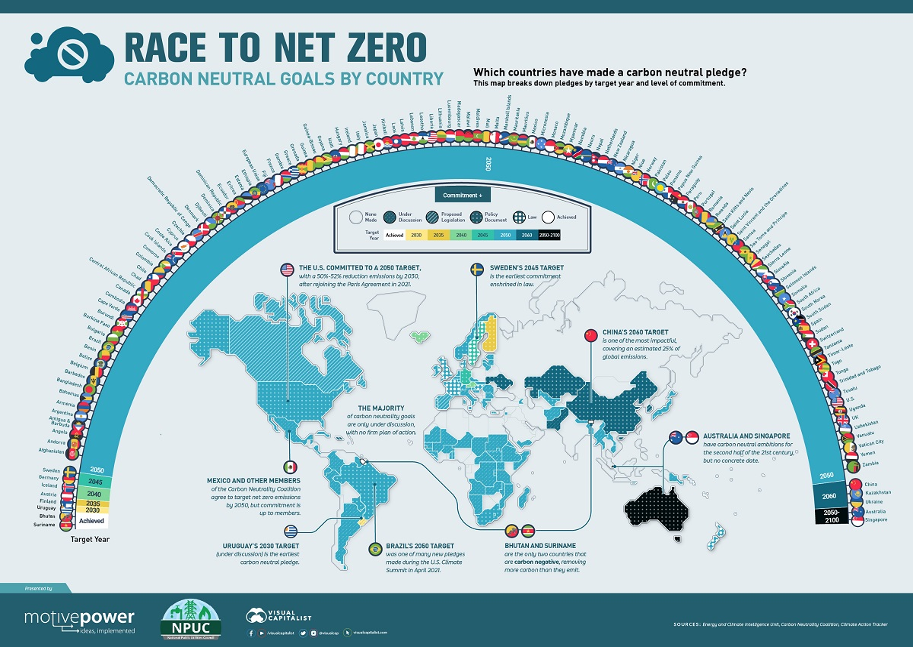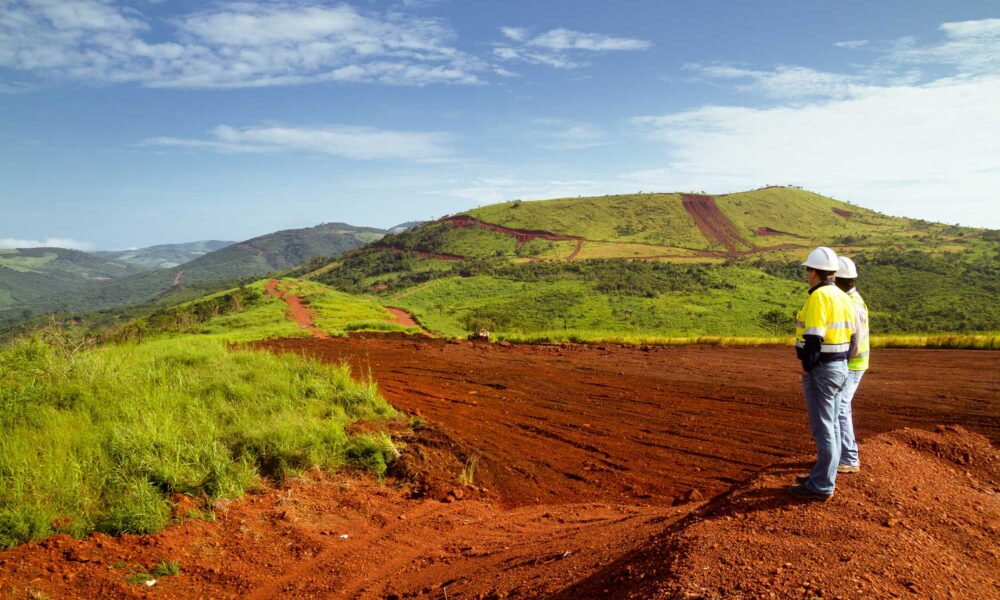Minnesota mining maze reveals the green energy dilemma
Sustainable energy and electric vehicles (EVs) will help pave the way to a cleaner, greener future and many countries have committed to bringing this to reality. Achieving those goals could conflict with a desire to protect unspoiled natural areas, and/or engender a level of dependency on authoritarian nations. Through this dilemma, however, we have identified an investment opportunity via some kind of copper ETF or perhaps a wider scope one like the CHRG ETF. What do investors need to know about the raw materials needed for green energy?
Global carbon commitments abound, but action is limited
On paper, the planet is as good as saved. 196 countries signed the Paris Agreement in 2015, pledging to take action to limit global temperature rise to below 2℃ above pre-industrial levels, and more have joined in the following years[1].
Since 2015, 37 countries have committed to carbon neutrality;[2] 6 nations, including the UK, France, and Denmark, have turned their commitment into law; and another 24 have enshrined it as part of government policy, including the US, Brazil, Chile, and Germany.[3]

Source: “Race to Net Zero: Carbon Neutral Goals by Country” Last updated July 20, 2022. https://www.visualcapitalist.com/sp/race-to-net-zero-carbon-neutral-goals-by-country/
But the UN’s Net Zero Coalition warns that current plans fall a long way short of what is required. Only 8 countries have achieved net zero thus far, most of which are tiny island nations[4]. According to the Net Zero Coalition, today’s commitments will actually see global greenhouse gas emissions increase by almost 11% above 2010 levels by 2030.[5]
There’s a major gap between intentions and action, which is hardly surprising. Few people are willing to significantly change their lifestyle today for the sake of averting a nebulous future disaster. Governments and organizations won’t hit their targets by simply cutting energy consumption.
Sustainable energy is the missing piece
What is needed is a climate-friendly, non-harmful energy alternative which allows people to continue to enjoy the ease of transportation, access to fresh produce and manufactured goods, and temperature control (air conditioning) that is currently available. In other words, sustainable energy from renewable sources, and electric vehicles (EVs) which use that energy.
Many countries have consequently passed laws incentivizing green energy production, and are investing in the necessary infrastructure and R&D. The Energy Policy Tracker calculates that in 2020-2021, governments in G20 countries[1] [2] , which constitute the highest-polluting countries in the world, committed at least $326.13 billion for potentially clean energy and over $204.11 billion for other green energy.[6]
These figures sound impressive, but they are not sufficient. The UN’s Framework Convention on Climate Change (UNFCCC) recently promoted a multi-agency report by the World Meteorological Organization (WMO). The report emphasized that in order to limit global temperature increase, the supply of sustainable energy must double within the next 8 years and investments must triple by 2050. Only 40% of climate action plans submitted to the UNFCCC prioritize energy adaptation, and investment is correspondingly low.[7]
“Switching to clean forms of energy generation, such as solar, wind and hydropower […] is vital if we are to thrive in the twenty-first century. Net zero by 2050 is the aim. But we will only get there if we double the supply of low-emissions electricity within the next eight years,” said WMO Secretary-General Professor Petteri Taalas.[8]
This is encouraging news for investors with the foresight to invest in futures markets for the vital commodities needed to enable renewable energy. Over the next several years, massive amounts of lithium, cobalt, copper, nickel, and other specific raw materials are going to be needed for EVs, lithium-ion batteries for storing renewable energy, pipelines for alternative fuels, and more.
However, accessing those raw materials is leading to unexpected conflicts.
The sustainability tug of war
“Ensuring secure, resilient and sustainable EV supply chains” is one of the 5 recommendations made by the IEA [3] (International Energy Agency) to support the development of Evs,[9] but it’s proving tricky to actualize. The aforementioned elements come from mines, many located in unstable nations such as the Democratic Republic of Congo, or controlled by repressive regimes such as China and Russia. Environmentally-aware nations are forced to choose between funding war and repression, or blocking the production of vital green energy infrastructure.
Many countries are searching for alternative sources of raw materials. But when such sources are found, they can provoke a conflict of interests. Mining is a destructive process that can harm existing ecosystems, but blocking it means forbidding access to the commodities needed to support a more planet-friendly way of life.
The conflict was thrown into sharp relief by recent events in the US, in the state of Minnesota. In 2019, Chilean mining company Antofagasta discovered a rich source of copper and nickel in northeast Minnesota, and proposed to develop an underground mine. The mine would help Antofagasta fill its copper deficit, and serve as the country’s only nickel mine, since the existing one is set to close by 2025.[10]
Permission was granted by the Trump administration, but a group of local businesses, environmental advocates and outdoor recreation groups challenged that ruling. On January 26, 2023, the Interior Secretary officially withdrew the land from the lease, preventing mining for at least the next 20 years.[11]
Just 11 days later, Minnesota’s governor signed a bill into law that requires all the state’s utilities to produce carbon-free electricity by 2040.[12] But without opening up areas of the natural world for mining, there will be no way to meet long-term climate goals. Minnesota has effectively tied its own hands.
Moving towards a cleaner future
It’s clear that the US needs to come up with a comprehensive plan for meeting carbon neutral goals, one which balances preserving areas of pristine nature, enabling sustainable energy and pollution-free transport, and reducing dependency on authoritarian regimes. Like other countries, it will have to take bold decisions that might temporarily sacrifice access to nature preserves in exchange for long term environmental improvements.
As nations face up to the need for raw materials to support their carbon commitments, and decide which path they will take to access them, investors can seize the opportunity. An ETF that offers broad exposure to the rising value of such commodities, like some types of copper ETFs [4] or other ETFs focused on core commodities, presents a way to benefit from the increasing demand for raw materials and support green energy.
[1] “The Paris Agreement” https://unfccc.int/process-and-meetings/the-paris-agreement
[2] “Race to Net Zero: Carbon Neutral Goals by Country” Last updated July 20, 2022 https://www.visualcapitalist.com/sp/race-to-net-zero-carbon-neutral-goals-by-country/
[3] “Race to Net Zero: Carbon Neutral Goals by Country” Last updated July 20, 2022 https://www.visualcapitalist.com/sp/race-to-net-zero-carbon-neutral-goals-by-country/
[4] “These 8 countries have already achieved net-zero emissions” December 16, 2022 https://www.weforum.org/agenda/2022/12/these-countries-achieved-net-zero-emissions/
[5] “For a livable climate: Net-zero commitments must be backed by credible action” 2022 https://www.un.org/en/climatechange/net-zero-coalition
[6] Energy Policy Tracker — G20 Countries. Updated December 31, 2021 https://www.energypolicytracker.org/region/g20/ . G20 countries are Argentina, Australia, Brazil, Canada, China, France, Germany, India, Indonesia, Italy, Japan, Republic of Korea, Mexico, Russia, Saudi Arabia, South Africa, Türkiye, the United Kingdom, the United States, and the European Union.
[7] “WMO – Clean Energy Must Double By 2030” October 11, 2022 https://unfccc.int/news/wmo-clean-energy-must-double-by-2030
[8] “WMO – Clean Energy Must Double By 2030” October 11, 2022 https://unfccc.int/news/wmo-clean-energy-must-double-by-2030
[9] “Global EV Outlook 2022” 2022 https://iea.blob.core.windows.net/assets/e0d2081d-487d-4818-8c59-69b638969f9e/GlobalElectricVehicleOutlook2022.pdf
[10] “US blocks mining in parts of Minnesota, dealing blow to Antofagasta’s Twin Metals copper project” January 26, 2023 https://www.mining.com/web/us-blocks-mining-in-parts-of-minnesota-dealing-latest-blow-to-antofagastas-copper-project/
[11] “US blocks mining in parts of Minnesota, dealing blow to Antofagasta’s Twin Metals copper project” January 26, 2023 https://www.mining.com/web/us-blocks-mining-in-parts-of-minnesota-dealing-latest-blow-to-antofagastas-copper-project/
[12] “Minnesota just passed a 100% clean energy bill – here’s what’s in it” February 7, 2023 https://electrek.co/2023/02/07/minnesota-just-passed-a-100-clean-energy-bill-heres-whats-in-it/
Investing in ETF’s involves risk, including possible loss of principal. International investing may be subject to special risks, including currency exchange rate volatility, political, social or economic instability, less publicly available information, less stringent investor protections, and differences in taxation, auditing and other financial practices. Investment in emerging market securities involves greater risk than that associated with investment in foreign securities of developed foreign countries. The Fund invests in securities of companies of all sizes, including those that have relatively small market capitalizations. Investments in securities of these companies involve greater risks than do investments in larger, more established companies. Derivatives include instruments and contracts that are based on, and are valued in relation to, one or more underlying securities, financial benchmarks or indices, such as futures, options, swap agreements and forward contracts. The Adviser may engage in speculative transactions which involve substantial risk and leverage, such as making short sales. The use of leverage by the Adviser may increase the volatility of the Fund. Because the Fund invests in financial instruments that are linked to different types of commodities from the metals sector, the Fund is subject to the risks inherent in the metals sector. Such risks may include, but are not limited to: general economic conditions or cyclical market patterns that could negatively affect supply and demand in a particular industry; changes in environmental conditions, energy conservation and environmental policies; competition for or depletion of resources; adverse labor relations; political or world events; increased regulatory burdens; changes in exchange rates; imposition of import controls; obsolescence of technologies; and increased competition or new product introductions. The exploration and development of mineral deposits involve significant financial risks over a significant period of time, which even a combination of careful evaluation, experience and knowledge may not eliminate. Few properties which are explored are ultimately developed into producing mines. The Fund invests in companies that are economically tied to the lithium industry, which may be susceptible to fluctuations in the underlying commodities market. Commodity prices may be influenced or characterized by unpredictable factors, including, where applicable, high volatility, changes in supply and demand relationships, weather, agriculture, trade, changes in interest rates and monetary and other governmental policies, action and inaction. Securities of companies held by the Fund that are dependent on a single commodity, or are concentrated on a single commodity sector, may typically exhibit even higher volatility attributable to commodity prices.
Shares are bought and sold at market price (not NAV) and are not individually redeemed from the Fund. The returns shown do not represent the returns you would receive if you traded shares at other times. Brokerage commissions will reduce returns. The market price returns are based on the official closing price of an ETF share or, if the official closing price isn’t available, the midpoint between the national best bid and national best offer (“NBBO”) as of the time the ETF calculates current NAV per share. NAVs are calculated using prices as of 4:00 PM Eastern Time.
The Energy & Minerals Group EV, Solar & Battery Materials (Lithium, Nickel, Copper, Cobalt) Futures Strategy ETF is distributed by Quasar Distributors, LLC.
Investors should carefully consider the investment objectives, risks, charges and expenses of the The Energy & Minerals Group EV, Solar & Battery Materials (Lithium, Nickel, Copper, Cobalt) Futures Strategy ETF. This and other important information about the Fund is contained in the Prospectus, which can be obtained by calling 1-800-617-0004 or visiting www.emgadvisors.com. The Prospectus should be read carefully before investing.


